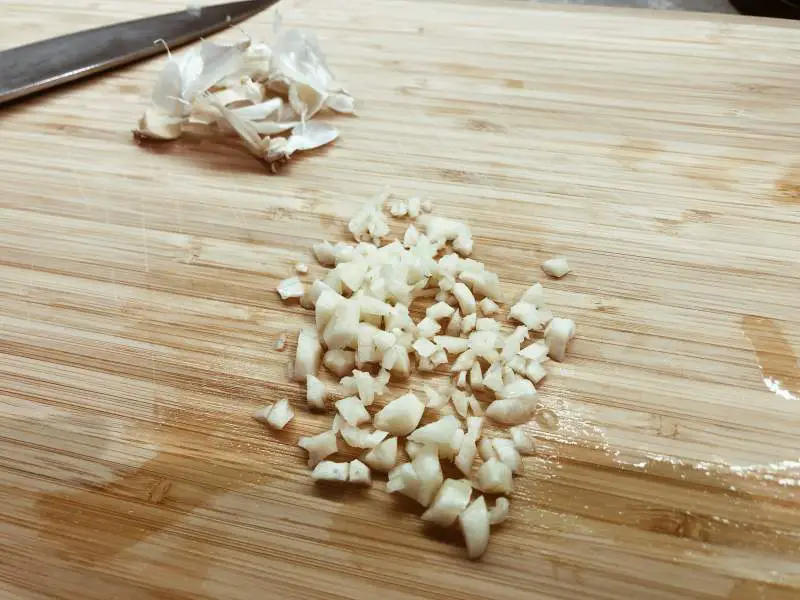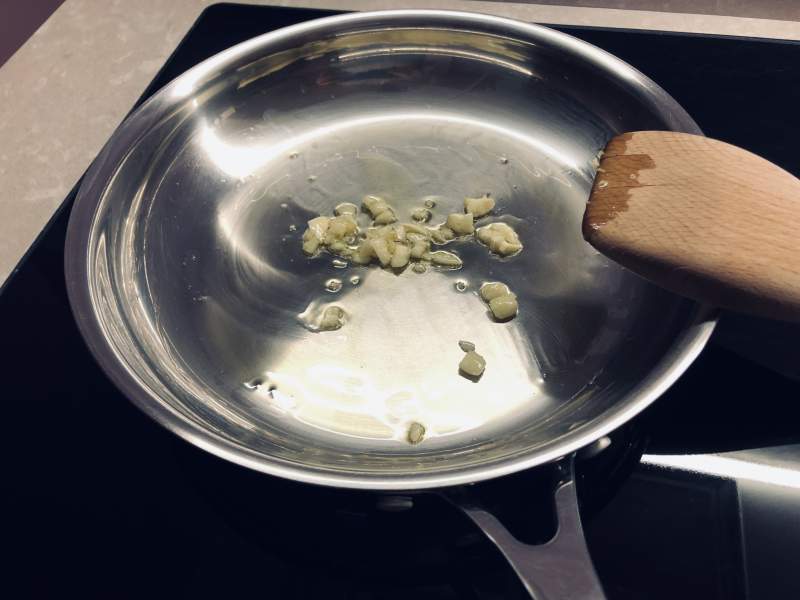I know from email exchanges and comments on other articles that many of you get intimidated by sautéing. After all, the name is French, and it sounds like sautéing is something pretty darn complicated to do.
The irony is that it’s one of the most straightforward cooking techniques out there. Sautéing means pan-frying food quickly, over medium to medium-high heat, and with as little cooking oil or fat as possible.
The trick to sautéing, especially when it comes to vegetables like garlic that burn fast, is to get the temperature and the timing right. This is what I’m going to be helping you do in this article. If I’ve got you curious, keep on reading.
How to Sauté Garlic in Olive Oil
Select a good olive oil. The best olive oil is extra-virgin olive oil from Greece, Spain, Portugal, and Italy in Europe, or from California in the U.S.
Peel and mince the garlic. How finely you’d like to chop it depends on what you’d like to cook with it. When I make a base for a tomato sauce, I want to mince the garlic as finely as possible to incorporate it perfectly with the tomatoes. If I’m making a base for a soup or stew, I’d probably go for bigger and rougher cuts.

Drizzle olive oil into your pan. To sauté garlic (or any other vegetable), you don’t need much olive oil. I usually add 1-2 tbsp of olive oil to my pan, which is just enough to cover its surface without drowning my garlic in fat.
When olive oil is at room temperature, it’s more viscous. Spread the oil on your pan’s cooking surface using a basting brush or a paper towel.
Or turn up the heat and wait for the oil to get up to temperature (after the next step); it will be easy to spread it by lifting the pan from the cooktop and moving it around.

Bring your pan up to heat. Take your time here. Sautéing works best when your food comes into sudden contact with hot oil. When you toss the garlic in your pan, you want the pan and the oil inside it to be sufficiently hot. So set your cooktop on medium or medium-high and allow your pan 2-3 minutes to preheat.
Cook the garlic for 15-30 seconds. Toss the chopped garlic in your frying pan and cook it, stirring, for 15 to 30 seconds. Garlic burns quickly, especially if you’re cooking it on relatively high heat. When it develops a golden color and releases its perfume into the air, it’s done.

Take the pan away from the heat or add the cooking liquid. As soon as the 15-30 seconds are done, either take the frying pan away from the heat or add cooking liquid, like beef broth or chicken stock, to cool down the pan.
Don’t leave it on the cooktop (unless you’re using an induction cooktop), as the residual heat from your burner can scorch the garlic.
Why You Should Sauté on Medium-High Heat
Olive oil is one of my favorite cooking oils. It’s healthy as its oil content consists of up to 73% oleic acid, monounsaturated fat. It also adds a bitter, tangy, and grassy taste to your meals as you cook with it.
One thing not everyone knows about olive oil is that it burns fast. Every cooking oil and animal fat has a smoke point, the temperature at which it stops to glisten and shimmer and starts to burn and smoke. And the smoke point of olive oil, compared to other cooking oils like canola or sunflower oil, is relatively low.
The smoke point of extra-virgin olive oil, or the only kind of olive oil you should be buying for your home kitchen, is 375°F (190°C). Heat olive oil to any temperature above it, and it will start to burn—emitting toxic fumes and losing its health benefits as a result.
What does this mean in practical terms when sautéing garlic?
When you sauté garlic in olive oil, use medium to medium-high heat. Olive oil has a low smoke point of 375°F (190°C), and garlic will burn at high heat. The outcome will be burnt garlic in a bitter-tasting oil with harmful compounds inside it.
Whether you should use medium or medium-high heat depends entirely on your pan and cooktop.
For example, I use a stainless steel frying pan on an induction cooktop. The pan has a thick base and distributes heat pretty evenly. Induction cooktops are very efficient in transmitting energy. So I end up sautéing garlic on setting 6 out of 9 on the heat dial.
Why Sauté Garlic?
Have you ever wondered why you should pan-fry garlic in the first place?
It all comes down to its aroma and flavor. Raw garlic has an aggressively acrid and bitter taste. When you cook garlic down, you soften and sweeten its taste.
It also releases its perfume and taste into the olive oil. Fats are an excellent carrier of aroma and flavor. As soon as you add the rest of the ingredients to your pan, your dish is going to come out naturally pleasant and garlicky.
Avoid this common mistake that most home cooks make when sautéing garlic: don’t keep cooking the garlic once it’s done (unless you’re adding colder ingredients to your pan and/or a cooking liquid like beef broth, chicken stock, or vegetable bouillon).
By the time you are done cooking the rest of the ingredients, the garlic will burn and ruin your dish’s overall taste.
Where Does the Term Sauté Come From?
I studied French in high school and haven’t had much of a chance to practice it since. Happily for me, I remembered this one. “Sautér” is a French verb that means to jump. “Sauté” is a team from ballet for a jump from two feet which lands on two feed.
The name of this cooking technique, it seems, comes from the fact that food tends to jump around in the frying pan when it comes into sudden contact with relatively-high heat. Or because professional chefs toss food in the pan, making it jump when they sauté it.
Conclusion
To sauté garlic, add 1-2 tbsp olive oil to your frying pan and preheat it on medium to medium-high for 2-3 minutes. Toss in the garlic and cook, stirring, for 15 to 30 seconds.
You know that the garlic is done when it’s released its perfume into the air in your kitchen and when its color turns golden. At this stage, take the pan away from the heat or cool it down by adding colder ingredients or cooking liquid.
Remember that garlic burns quickly—and olive oil has a low smoke point—so there’s absolutely no use in cooking on high heat. At best, the garlic will come out scorched on the outside and raw on the inside, and the olive oil is going to emit toxic smoke and develop harmful compounds.
What are your best tricks and techniques for sautéing garlic in olive oil? Let me and the rest of this post’s readers know by leaving a comment below.
